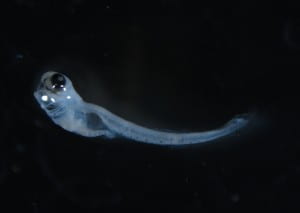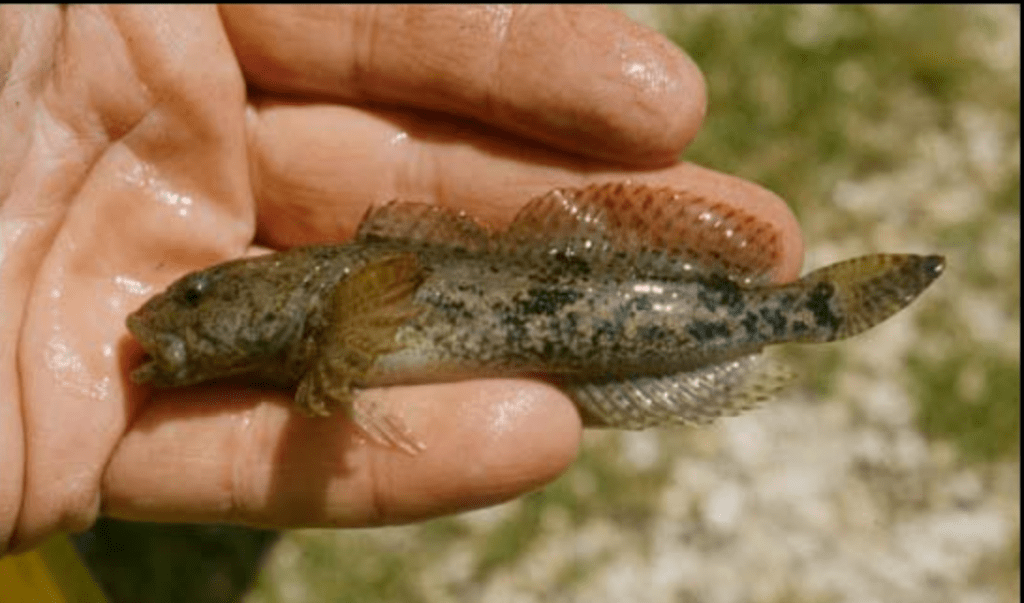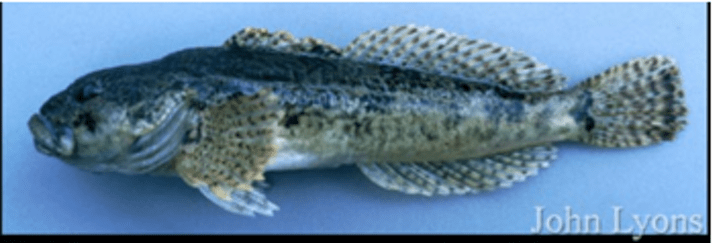Key Characteristics:
- 36-43 total myomeres
- Body elongated
- Melanophores may appear along dorsum of (inside lining of fish) peritoneum

Larval Mottled Sculpin. 5 mm. United States Fish & Wildlife Service. Green Bay, WI. Marian Shaffer. 2017.
- Body not elongated, eel-shaped, round in transverse section, uniformly pigmented (1B)
- Chin barbels absent (3B)
- Snout short, its length usually less than 10% TL; median fins otherwise (5B)
- Median fins or finfolds showing distinct separation (7B)
- No adipose fin, or demarcation of one, in finfold (10B)
- Preanal myomeres significantly less than postanal myomeres (difference greater than five myomeres) (14B)
- Postanal myomeres less than 35, total myomeres less than 50, chin barbel absent (16B)
- Postanal myomeres less than 25, preanal length usually greater than 40% TL (17B)
- Mouth Terminal or inferior; usually two dorsal fins (18B)
- Pectoral fins well developed; head depressed; swim bladder not visible (19A)
- Cottidae
Or*
- Body not elongated, eel-shaped, round in transverse section, uniformly pigmented (1B)
- Chin barbels absent (3B)
- Snout short, its length usually less than 10% TL; median fins otherwise (5B)
- Median fins or finfolds continuous, or nearly so (7A)
- Pectoral fins large and usually well developed; lower jaw without barbel; urostyle upturned or notochord straight, if straight caudal fin rays developed on ventral half only (8B)
- Larva sparsely pigmented; often exhibiting “saddle markings” on dorsum; opercle often with spine(s); notochord flexed; mouth subterminal (9B)
- Cottidae
Adult History
- Physical Description
- Lacks scales, terminal and wide mouth, separate thoracic pelvic fins (1 spine and 4 rays each) (wing-like), eyes on top of broad head, spotted brown/black coloration, two dorsal fins (first: 6-9 spines/second: 17-19 rays), small black spot on the first dorsal fin while also having a larger black spot on the back of the first dorsal fin, and rounded snouts
- Spawning Habitat
- Streams and shoreline areas of lakes
- Between a depth of 15 – 35 centimeters
- Spawning Substrate
- Eggs are deposited on aquatic vegetation, soil cavities, an underside of objects, or gravel bottoms
- Spawning Behavior
- Polygynandry Behavior
- Males migrate to the shoreline
- Spawning Physical Characteristics
- Males have a darker band on the first dorsal fin
- Orange band on the edge of the fin
- Courtship Behavior
- Raise their gills, shake their heads, and undulate their bodies
- Males bite females on the tail, fins, cheeks, or sides and drag her into the nest
- Female releases her eggs by turning upside down
- Males’ head and fins will turn black and his body pale while protecting his nest
- Allow other females to spawn in his cavity
- Males defend their nests or cavities until their young become independent
- Time of Year
- March/April – May in Lake Michigan
- Spawning typically takes place at water temperatures of 40 – 65°F
- Diet
- Leaves, algae, small fish, eggs, aquatic insect larvae, and aquatic crustaceans

Adult Mottled Sculpin. UW – Sea Grant, UW – Madison, and NOAA. John Lyons. 2013.

